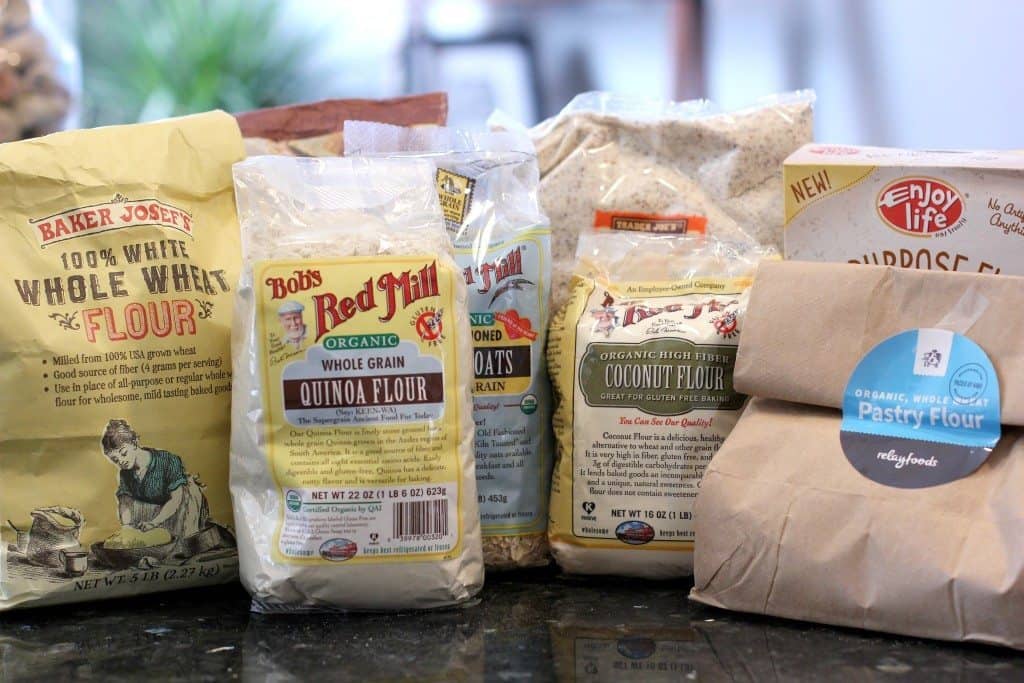Source:
I Heart Vegetables
When I started thinking about doing a post about some of my favorite
flours (and flour alternatives) I thought I’d only have a handful to
share. But once I started pulling things out of my pantry, I realized I
had quite a few flours in there. Some of them are interchangeable and
some work best in a few recipes and not so well in others. Some are
cheap, some are expensive, and some are harder to find than others. So I
thought I’d make you a little guide to the various flours you might see
on my blog or across Pinterest. Hopefully this makes it easier for you
when you’re at the grocery store!
So here’s the run down of all the different types of flours I have in my pantry:
Whole Wheat Flour-
You might already have this at home! Whole wheat flour contains the
entire kernel of hard red wheat, which is what gives it a darker color
than white flour. It’s high in nutrients and fiber which is why I love
using it in recipes! If you’re swapping it out for all-purpose flour
start with a half all purpose/half whole wheat blend. If you switch to
all whole wheat, it can get sort of chewy and dry.
White Whole Wheat Flour–
This has recently become one of my favorite flours. It has the
nutrients and fiber of whole wheat flour, but it’s an easier swap for
all purpose flour. The wheat flavor isn’t as strong, so depending on the
recipe, you can often swap this 1:1 for all purpose flour. This is the
perfect place to start when baking for people who think they hate whole
wheat flour. I used it in this
whole wheat flatbread recipe and they have a great texture!
Whole Wheat Pastry Flour-
This flour comes from soft white wheat. The lower protein content of
this flour makes it great for whole grain baked goods. It’s pretty
similar to white whole what flour, but I think it’s a bit better in
baked goods. I used it in these
chocolate avocado muffins and it was perfect!
Gluten Free Flour: Gluten free flour can be tricky, but I’ve had a lot of success with
Enjoy Life Foods all-purpose flour blend.
It’s a combination of grains (Millet, Rice, Teff, Buckwheat, Rice
Starch, Tapioca Starch, Brown Rice Protein, & Sprouted Brown Rice
Protein) and it works well in baked goods or as a general substitute for
flour. It measures 1:1 just like regular flour. I’ve used it in
this falafel recipe to keep it vegan.
Coconut Flour–
I think this is one of the harder flours to work with. Baked goods tend
to get pretty dense, but if you’re paleo, this is a popular choice.
I’ve it in a recipe for
gluten free protein donuts and it worked fairly well. (Although I prefer
this recipe for cinnamon sugar mini protein donuts!)
Coconut flour isn’t an easy swap but if you play around with it for a
bit, it can be a nice gluten free, high fiber flour option.
Quinoa Flour–
I’ve loved playing around with quinoa flour but I’ll warn you, it’s
expensive. I like to keep it real over here so I know not everyone wants
to shell out $16 for a bag of flour. It’s great for special diets
though, since it’s gluten free and quinoa is a “complete protein”
meaning it contains all the essential amino acids. That’s helpful for
vegans! It also offers more protein than all purpose flour. If you want
to try baking with quinoa flour, try these
quinoa chocolate chip cookies!
Oat Flour–
Technically, you can buy oat flour but you can also make it pretty
easily. I just toss rolled oats in the blender or food processor until I
get to a flour-like texture. It can be a great gluten-free “flour” for
baked goods, but it will definitely change the texture of the final
product. If you want to start by substituting part of the flour in a
recipe, start with about 20%.
Almond Flour-
Again, this one is on the pricy side, but you can make your own with
almonds from the bulk bin, or buy some almond flour (somtimes called
“almond meal”) from Trader Joe’s where it tends to be a bit cheaper.
It’s a great high protein, gluten free substitute but keep in mind that
it’s much higher in calories. I love it in these
almond flour brownies and these
sugar free dark chocolate truffles, but I haven’t used it for things like muffins or bread. It tends to be pretty dense.
Who
knew there were so many flour options?! If I’m baking for myself, I
typically use white whole wheat flour. I personally think it’s the
easiest substitute and it offers a good amount of protein and fiber. But
if you’re gluten free or you’re following a special diet, there are
some great flour alternatives!
 Ingredients:
Ingredients: Edge crimping demo
Edge crimping demo











![Roasted Sweet Potatoes and Brussels Sprouts with Balsamic and Parmesan [KalynsKitchen.com] Roasted Sweet Potatoes and Brussels Sprouts with Balsamic and Parmesan [KalynsKitchen.com]](https://k8643br9gv-flywheel.netdna-ssl.com/wp-content/uploads/2015/11/sweet-potato-brussels-sprouts-collage2.jpg)










